Evaluating the Regional Economic Impacts of High-Speed Rail and Interregional Disparity: A Combined Model of I/O and Spatial Interaction
Abstract
:1. Introduction
2. Literature Review
3. Methodology and Data
3.1. Model Setting
3.2. Data Used
3.2.1. Production Value and Input Coefficients
3.2.2. Generalized Travel Cost
3.2.3. Distance Decay Parameter
4. Estimation and Results
4.1. Estimated Parameter
4.2. Regional Economic Impacts Evaluation
5. Conclusions
Author Contributions
Funding
Institutional Review Board Statement
Informed Consent Statement
Data Availability Statement
Conflicts of Interest
References
- National High Speed Rail Corporation Limited, MAHSR Operational Plan. Available online: https://www.nhsrcl.in/en/project/mahsr-project-operational-planss (accessed on 10 July 2022).
- OpenStreetMap. Available online: https://www.openstreetmap.org/#map=6/16.286/77.124 (accessed on 10 July 2022).
- Ministry of Home Affairs, Government of India, Census Tables, D-01. Available online: https://censusindia.gov.in/census.website/data/census-tables (accessed on 10 July 2022).
- Statistics Bureau of Japan, 1960 Population Census, Population, Area and Population Density for Shi, Ku, Machi and Mura: 1960. Available online: https://www.e-stat.go.jp/en/stat-search/files?page=1&layout=datalist&toukei=00200521&tstat=000001036867&cycle=0&tclass1=000001037497&tclass2val=0 (accessed on 10 July 2022).
- Ministry of Home Affairs, Government of India, Census Tables, B-04. Available online: https://censusindia.gov.in/census.website/data/census-tables (accessed on 10 July 2022).
- Statistics Bureau of Japan, 1960 Population Census, Industry (Minor Group) of Employed Persons 15 Years Old and Over by Employment Status and Sex, for All Japan, Prefectures and 6 Major Cities. Available online: https://www.e-stat.go.jp/en/stat-search/files?page=1&layout=datalist&toukei=00200521&tstat=000001036867&cycle=0&tclass1=000001038048&tclass2val=0 (accessed on 10 July 2022).
- Central statistics office, Ministry of statistics and programme implementation, Government of India, Input-Output table 2007–08, 2012. Available online: http://164.100.161.63/publication/input-output-transactions-table-2007-08 (accessed on 10 July 2022).
- Ministry of Internal Affairs and Communications, Input-Output Table, 1960. Available online: https://www.soumu.go.jp/toukei_toukatsu/data/io/960index.htm (accessed on 10 July 2022). (In Japanese)
- Vickerman, R. Can high-speed rail have a transformative effect on the economy? Transp. Policy 2018, 62, 31–37. [Google Scholar] [CrossRef]
- Blanquart, C.; Koning, M. The local economic impacts of high-speed railways theories and facts. Eur. Transp. Res. Rev. 2017, 9, 1–14. [Google Scholar] [CrossRef]
- Chen, C.; Loukaitou-Sideris, A.; De Ureña, J.M.; Vickerman, R. Spatial short and long-term implications and planning challenges of high-speed rail: A literature review framework for the special issue. Eur. Plan. Stud. 2019, 27, 415–433. [Google Scholar] [CrossRef]
- Chen, G.; Silva, J.A. Estimating the provincial economic impacts of high-speed rail in Spain: An application of structural equation modelling. Procd. Soc. Behv. 2014, 111, 157–165. [Google Scholar] [CrossRef]
- Li, X.; Huang, B.; Li, R.; Zhang, Y. Exploring the impact of high speed railways on the spatial redistribution of economic activities-Yangtze River Delta urban agglomeration as a case study. J. Transp. Geogr. 2016, 57, 194–206. [Google Scholar] [CrossRef]
- Cheng, Y.; Loo, B.P.Y.; Vickerman, R. High-speed rail networks, economic integration and regional specialisation in China and Europe. Travel Behav. Soc. 2015, 2, 1–14. [Google Scholar] [CrossRef]
- Vickerman, R. High-speed rail and regional development: The case of intermediate stations. J. Transp. Geogr. 2015, 42, 157–165. [Google Scholar] [CrossRef]
- Department for Transport, Transport Analysis Guidance (TAG) Unit A2-1 Wider Economic Impacts Appraisal, May 2019. Available online: https://www.gov.uk/government/publications/tag-unit-a2-1-wider-economic-impacts (accessed on 10 July 2022).
- Deng, T. Impacts of transport infrastructure on productivity and economic growth: Recent advances and research challenges. Transp. Rev. 2013, 33, 686–699. [Google Scholar] [CrossRef]
- Rice, P.; Venables, A.J.; Patacchini, E. Spatial determinants of productivity: Analysis for the regions of Great Britain. Reg. Sci. Urban Econ. 2006, 36, 727–752. [Google Scholar] [CrossRef]
- Chèze, C.; Nègre, R. Wider economic impacts of high-speed rail: Example of agglomeration benefits assessment on Bretagne Pays de Loire high speed rail project. Transport. Res. Procedia 2017, 25, 5307–5324. [Google Scholar] [CrossRef]
- Thanh, T.T.M.; Derrible, S. Assessing the wider economic impacts of transport infrastructure investment with an illustrative application to the North-South High-Speed Railway Project in Viet Nam. In Frontiers in High-Speed Rail Development; Hayashi, Y., Rothengatter, W., Seetha Ram, K.E., Eds.; Asian Development Bank Institute: Tokyo, Japan, 2021; pp. 181–196. [Google Scholar]
- Chen, C.; Hall, P. The wider spatial-economic impacts of high-speed trains: A comparative case study of Manchester and Lille sub-regions. J. Transp. Geogr. 2012, 24, 89–110. [Google Scholar] [CrossRef]
- Komikado, H.; Morikawa, S.; Bhatt, A.; Kato, H. High-speed rail, inter-regional accessibility, and regional innovation: Evidence from Japan. Technol. Forecast. Soc. 2021, 167, 120697. [Google Scholar] [CrossRef]
- Yi, Y.; Kim, E. Spatial economic impact of road and railroad accessibility on manufacturing output: Inter-modal relationship between road and railroad. J. Transp. Geogr. 2018, 66, 144–153. [Google Scholar] [CrossRef]
- Tavasszy, L.A.; Thissen, M.J.P.M.; Oosterhaven, J. Challenges in the application of spatial computable general equilibrium models for transport appraisal. Res. Transp. Econ. 2011, 31, 12–18. [Google Scholar] [CrossRef]
- Koike, A.; Ishikura, T.; Miyashita, M.; Tsuchiya, K. Spatial Economic Analysis for Intercity Transport Policies. In Intercity Transport and Climate Change; Hayashi, Y., Morichi, S., Oum, T., Rothengatter, W., Eds.; Springer: Berlin/Heidelberg, Germany, 2014; pp. 177–213. [Google Scholar]
- Han, J.; Hayashi, Y.; Jia, P.; Yuan, Q. Economic Effect of High-Speed Rail: Empirical analysis of Shinkansen’s impact on industrial location. J. Transp. Eng. 2012, 138, 1551–1557. [Google Scholar] [CrossRef]
- Nakamura, H.; Hayashi, Y.; Miyamoto, K. A land use-transport model for metropolitan areas. Pap. Reg. Sci. Assoc. 1983, 51, 43–63. [Google Scholar] [CrossRef]
- Miyamoto, K.; Nakamura, H.; Hayashi, Y. Industrial location model in metropolitan areas. Proc. Jpn. Soc. Civ. Eng. 1983, 339, 155–165. (In Japanese) [Google Scholar] [CrossRef]
- Sugimori, S.; Hayashi, Y.; Takeshita, H. Empirical analysis on industrial sectors for quality of life improvement along high-speed rail corridors. In Frontiers in High-Speed Rail Development, 1st ed.; Hayashi, Y., Rothengatter, W., Seetha Ram, K.E., Eds.; Asian Development Bank Institute: Tokyo, Japan, 2021; pp. 218–228. [Google Scholar]
- Japan International Cooperation Agency (JICA), Ministry of Railways, Republic of India (MOR), Joint Feasibility Study for Mumbai-Ahmedabad High Speed Railway Corridor, Final Report, July 2015. Available online: https://www.nhsrcl.in/en/project/feasibility-study-report (accessed on 10 July 2022).
- Railway Bureau, Ministry of Land, Infrastructure, Transport and Tourism. Appraisal Method Manual for Railway Projects, 2012. Available online: https://www.mlit.go.jp/tetudo/tetudo_fr1_000040.html (accessed on 10 July 2022). (In Japanese)
- Central Japan Railway Company, Fares and Surcharges. Available online: https://global.jr-central.co.jp/en/info/fare/ (accessed on 10 July 2022).
- Ministry of Land, Infrastructure, Transport and Tourism, 2015 Inter-Regional Travel Survey in Japan. Available online: https://www.mlit.go.jp/sogoseisaku/soukou/sogoseisaku_soukou_fr_000016.html (accessed on 10 July 2022).
- Gutiérrez, J. Location, economic potential and daily accessibility: An analysis of the accessibility impact of the high-speed line Madrid-Barcelona-French border. J. Transp. Geogr. 2001, 9, 229–242. [Google Scholar] [CrossRef]
- Venables, A.J.; Laird, J.; Overman, H. Transport Investment and Economic Performance: Implications for Project Appraisal. 2014. Available online: https://assets.publishing.service.gov.uk/government/uploads/system/uploads/attachment_data/file/386126/TIEP_Report.pdf (accessed on 10 July 2022).
- Graham, D.J.; Gibbons, S.; Martin, R. Transport Investment and the Distance Decay of Agglomeration Benefits. 2009. Available online: https://www.researchgate.net/publication/228793866_Transport_investment_and_the_distance_decay_of_agglomeration_benefits (accessed on 10 July 2022).
- Department for Transport, Transport Analysis Guidance (TAG) Unit A2-4 Productivity Impacts, May 2020. Available online: https://www.gov.uk/government/publications/tag-unit-a2-4-productivity-impacts (accessed on 10 July 2022).
- Hayashi, Y.; Mimuro, A.; Han, J.; Kato, H. The Shinkansen and its impacts. In High-Speed Rail and Sustainability; Henriquez, B.L.P., Deakin, E., Eds.; Routledge: New York, NY, USA, 2017; pp. 34–49. [Google Scholar]
- Hayashi, Y.; Morita, H.; Takeshita, H.; Kachi, N.; Kato, H. (Eds.) Mainstreaming Quality of Life in Evaluation of Transport and Spatial Planning, 1st ed.; Akashi Shoten: Tokyo, Japan, 2021; 380p. (In Japanese) [Google Scholar]
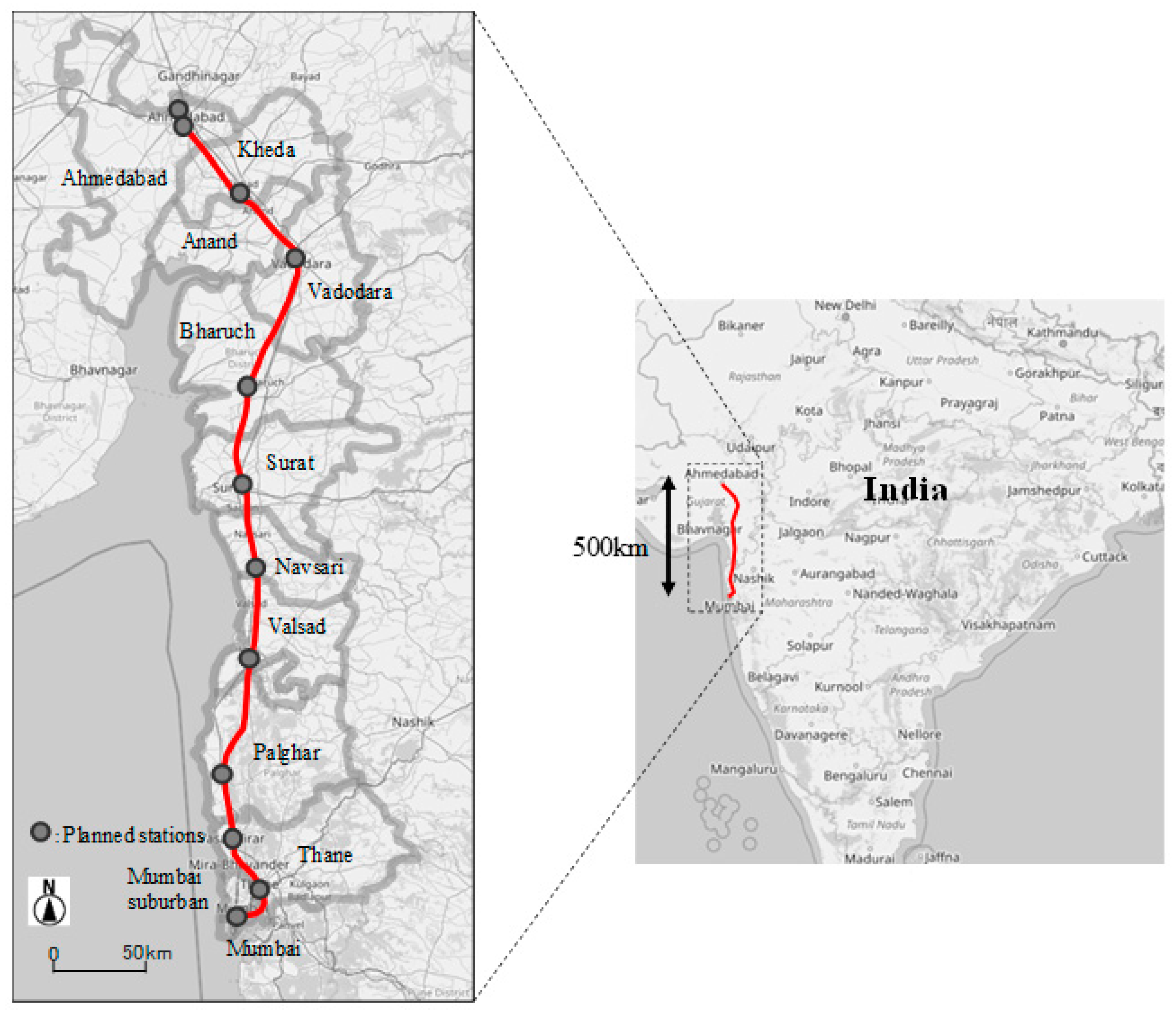
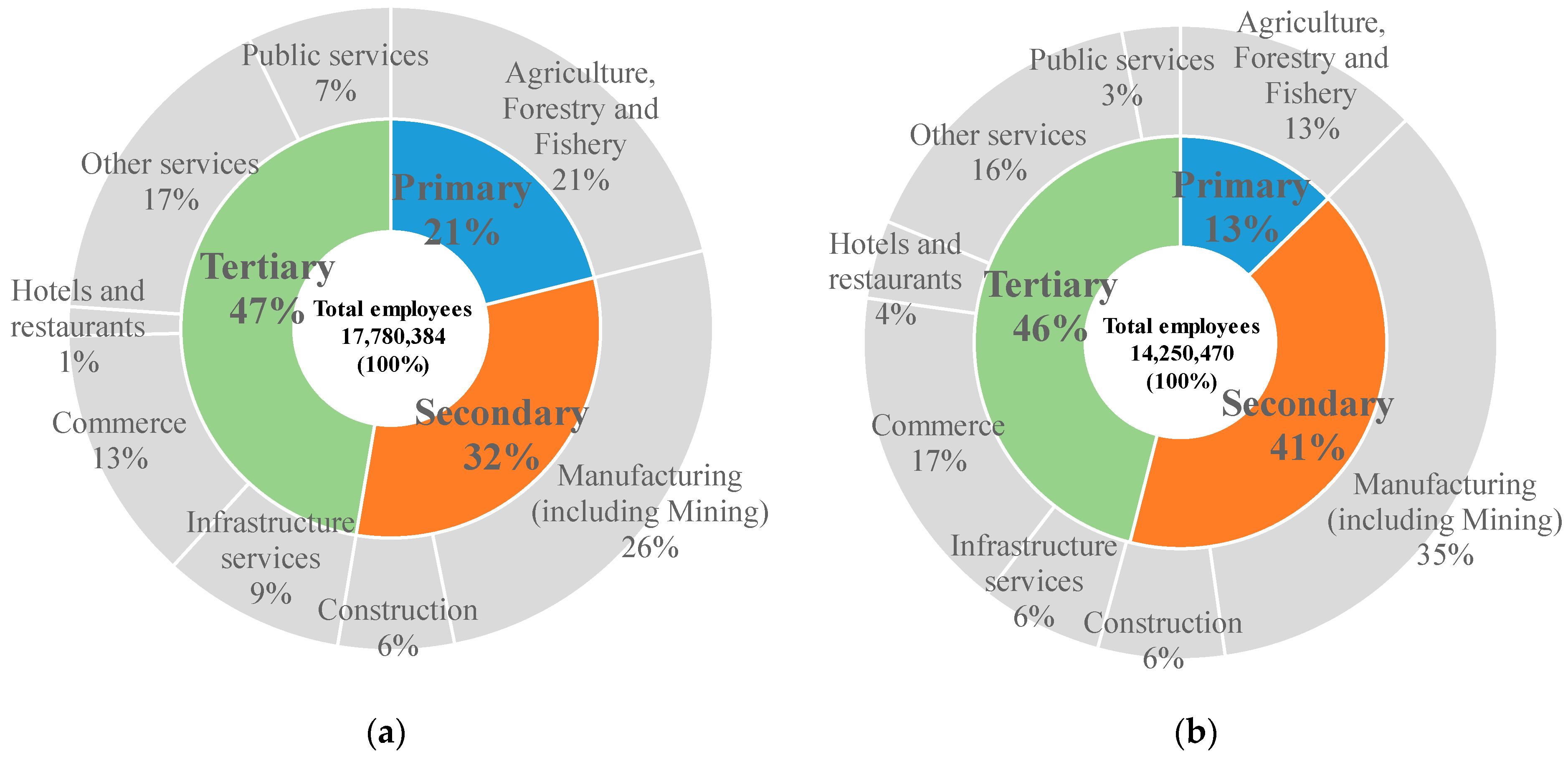
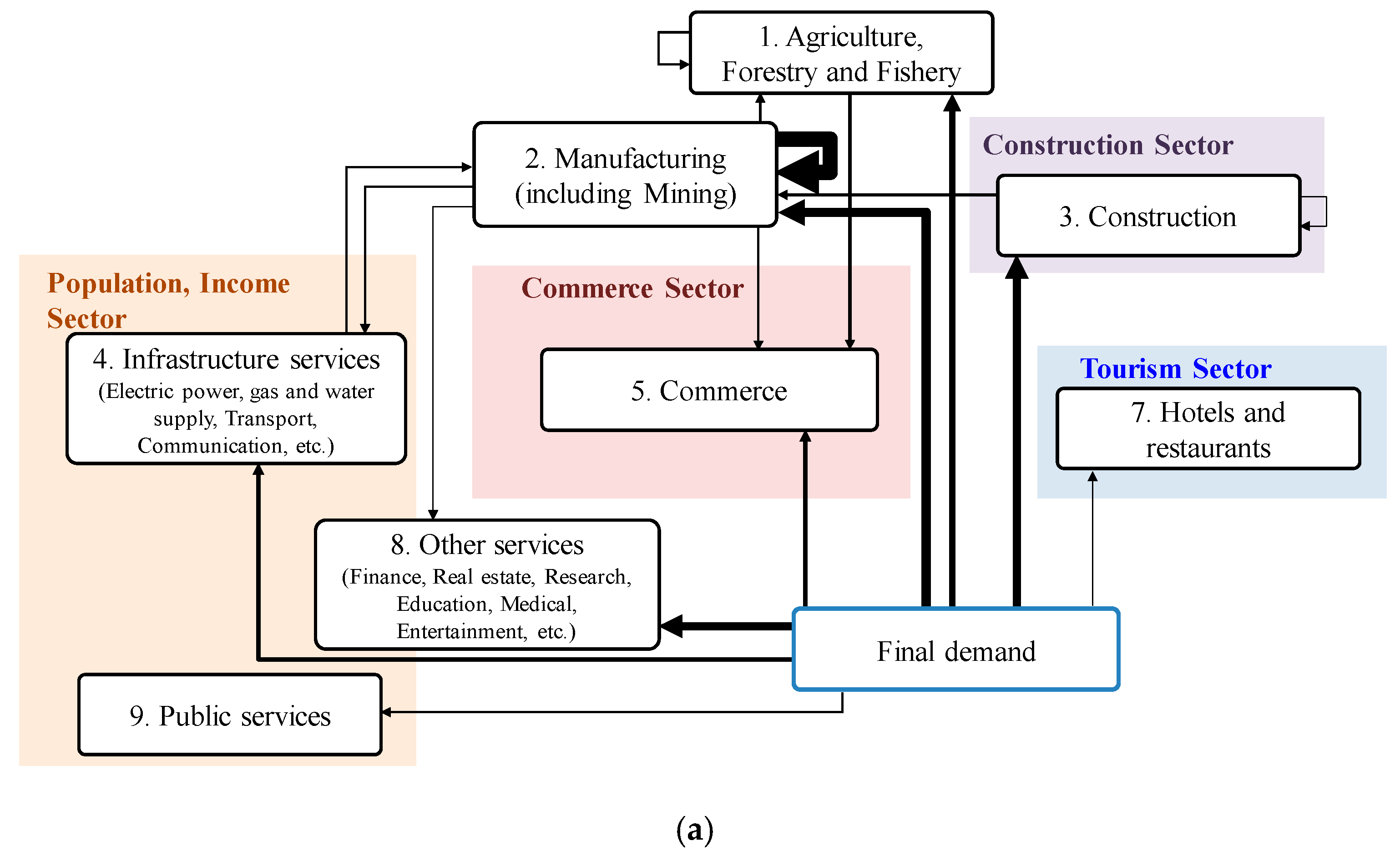
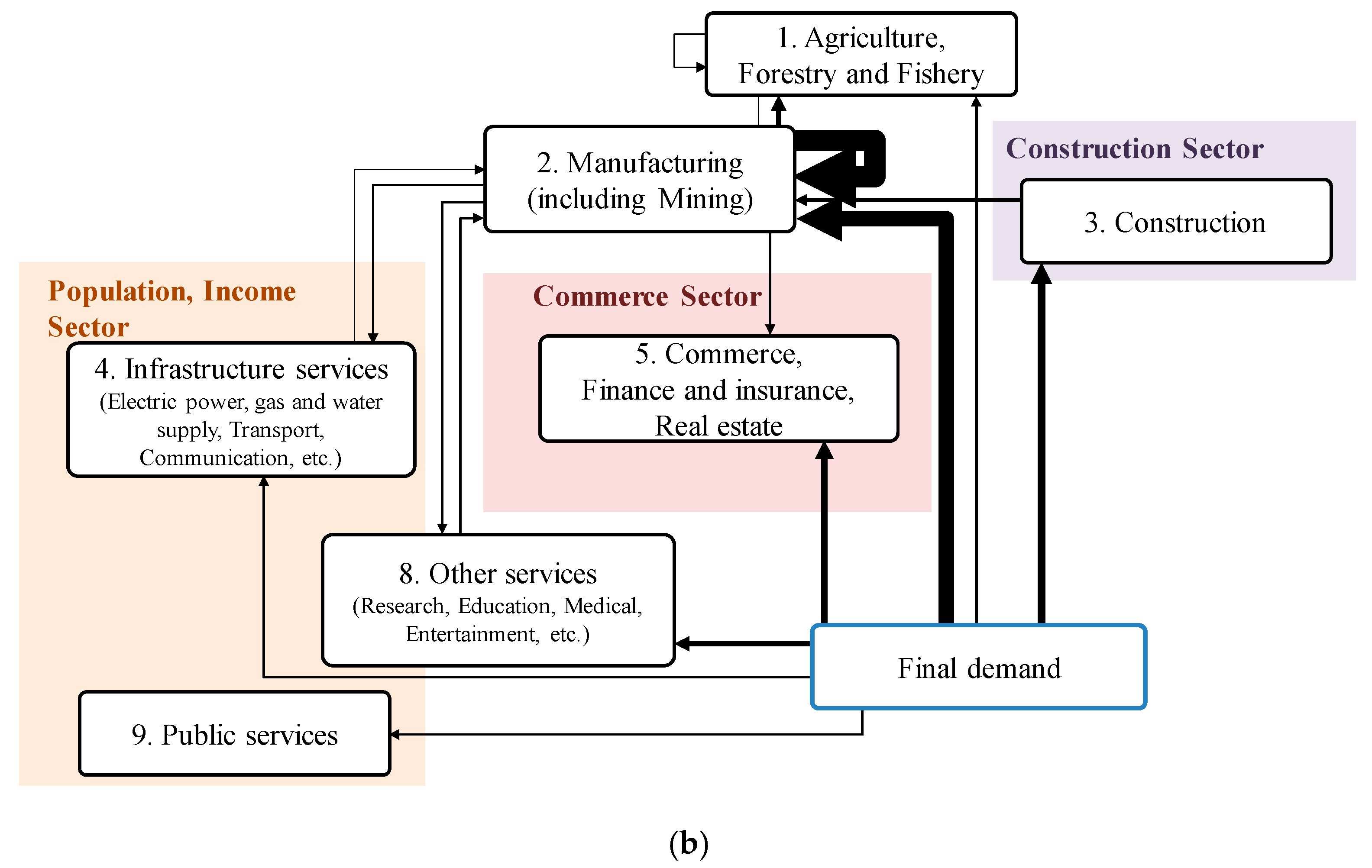
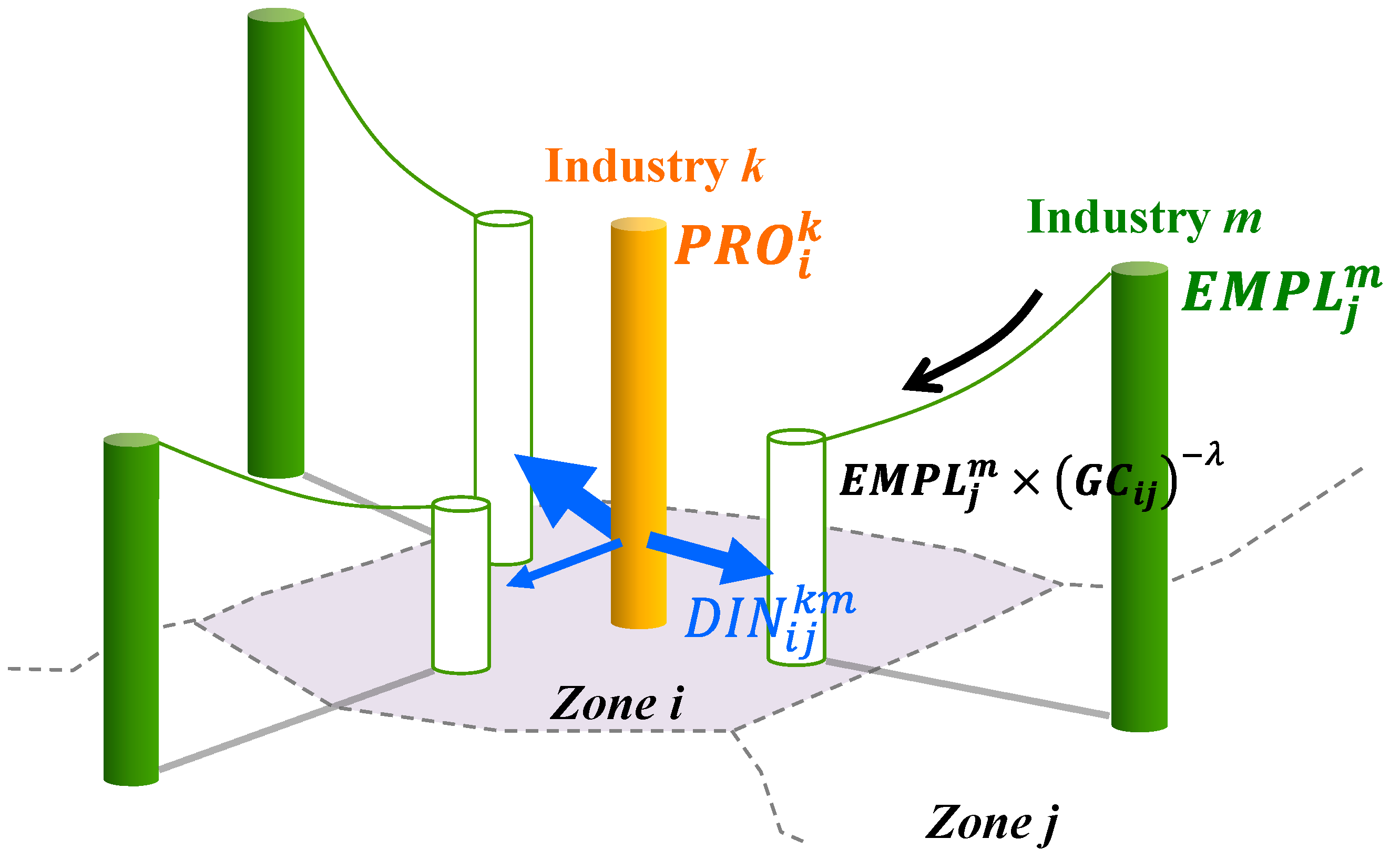
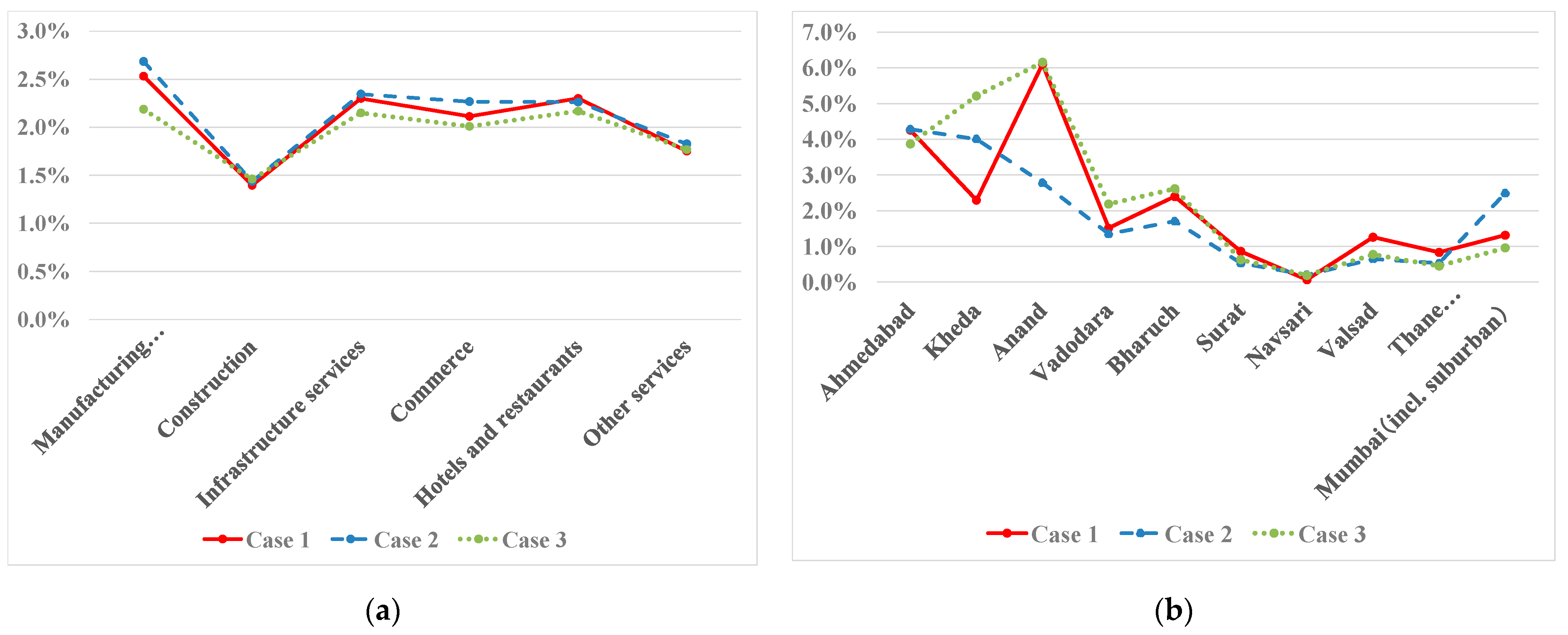
| State | District | Population | Population Density (per km2) |
|---|---|---|---|
| Gujarat | Ahmedabad | 7,214,225 | 890 |
| Kheda | 2,299,885 | 582 | |
| Anand | 2,092,745 | 653 | |
| Vadodara | 4,165,626 | 552 | |
| Bharuch | 1,551,019 | 238 | |
| Surat | 6,081,322 | 1337 | |
| Navsari | 1,329,672 | 592 | |
| Valsad | 1,705,678 | 567 | |
| Maharashtra | Thane (including Palghar) | 11,060,148 | 1157 |
| Mumbai (including suburban) | 12,442,373 | 20,634 | |
| Total | 49,942,693 | 1013 (average) | |
| Industries and Services | Agriculture, Forestry and Fishery | Manufacturing (Including Mining) | Construction | Infrastructure Services | Commerce | Hotels and Restaurants | Other Services | Public Services | Final Consumption Demand |
|---|---|---|---|---|---|---|---|---|---|
| Agriculture, forestry, and fishery | 0.19 | 0.07 | 0.03 | 0.01 | 0.00 | 0.25 | 0.00 | 0.00 | 0.10 |
| Manufacturing (including mining) | 0.06 | 0.47 | 0.30 | 0.27 | 0.06 | 0.20 | 0.05 | 0.00 | 0.36 |
| Construction | 0.01 | 0.01 | 0.12 | 0.01 | 0.00 | 0.02 | 0.02 | 0.00 | 0.14 |
| Infrastructure services | 0.03 | 0.08 | 0.06 | 0.08 | 0.06 | 0.05 | 0.04 | 0.00 | 0.10 |
| Commerce | 0.05 | 0.07 | 0.07 | 0.05 | 0.01 | 0.09 | 0.00 | 0.00 | 0.09 |
| Hotels and restaurants | 0.00 | 0.00 | 0.00 | 0.05 | 0.01 | 0.04 | 0.02 | 0.00 | 0.02 |
| Other services | 0.01 | 0.04 | 0.04 | 0.04 | 0.05 | 0.02 | 0.07 | 0.00 | 0.16 |
| Public services | 0.00 | 0.00 | 0.00 | 0.00 | 0.00 | 0.00 | 0.00 | 0.00 | 0.03 |
| Value added | 0.65 | 0.26 | 0.38 | 0.48 | 0.81 | 0.33 | 0.80 | 1.00 | - |
| Total | 1.00 | 1.00 | 1.00 | 1.00 | 1.00 | 1.00 | 1.00 | 1.00 | 1.00 |
| Ahmedabad | Kheda | Anand | Vadodara | Bharuch | Surat | Navsari | Valsad | Thane | Mumbai | |
|---|---|---|---|---|---|---|---|---|---|---|
| Ahmedabad | 249 | 592 | 958 | 1252 | 1996 | 2688 | 2944 | 3232 | 4831 | 5573 |
| Kheda | 592 | 223 | 419 | 792 | 1572 | 2232 | 2526 | 2820 | 3466 | 5197 |
| Anand | 958 | 419 | 193 | 439 | 1227 | 1853 | 2156 | 2459 | 3204 | 5041 |
| Vadodara | 1252 | 792 | 439 | 323 | 914 | 1550 | 1853 | 2166 | 2920 | 4805 |
| Bharuch | 1996 | 1572 | 1227 | 914 | 387 | 712 | 1035 | 1348 | 2428 | 3732 |
| Surat | 2688 | 2232 | 1853 | 1550 | 712 | 267 | 419 | 722 | 1820 | 3064 |
| Navsari | 2944 | 2526 | 2156 | 1853 | 1035 | 419 | 186 | 409 | 1506 | 2559 |
| Valsad | 3232 | 2820 | 2459 | 2166 | 1348 | 722 | 409 | 366 | 1146 | 2232 |
| Thane | 4831 | 3466 | 3204 | 2920 | 2428 | 1820 | 1506 | 1146 | 545 | 1136 |
| Mumbai | 5573 | 5197 | 5041 | 4805 | 3732 | 3064 | 2559 | 2232 | 1136 | 551 |
| Case 1 | Case 2 | Case 3 | |
|---|---|---|---|
| Agriculture, forestry, and fishery | 1.655 | 1.000 | 1.800 |
| Manufacturing (including mining) | 1.097 | 1.000 | 1.800 |
| Construction | 1.562 | 1.000 | 1.800 |
| Infrastructure services | 1.818 | 1.000 | 1.800 |
| Commerce | 1.818 | 1.000 | 1.800 |
| Hotels and restaurants | 1.818 | 1.000 | 1.800 |
| Other services | 1.746 | 1.000 | 1.800 |
| Public services | 1.655 | 1.000 | 1.800 |
| R2 | |||
|---|---|---|---|
| Agriculture, forestry, and fishery | 0.988 | 0.144 | 0.53 |
| (3.34) | (0.04) | ||
| Manufacturing (including mining) | 0.959 | 0.634 | 0.99 |
| (35.01) | (1.63) | ||
| Construction | 0.976 | 0.290 | 0.97 |
| (16.71) | (0.39) | ||
| Infrastructure services | 1.031 | −0.536 | 0.94 |
| (11.42) | (−0.46) | ||
| Commerce | 0.957 | 0.548 | 0.97 |
| (15.69) | (0.71) | ||
| Hotels and restaurants | 1.077 | −1.191 | 0.92 |
| (10.48) | (−1.04) | ||
| Other services | 0.971 | 0.349 | 0.95 |
| (12.85) | (0.35) | ||
| Public services | 1.186 | −2.611 | 0.91 |
| (9.29) | (−1.90) |
| Ahmedabad | Kheda | Anand | Vadodara | Bharuch | Surat | Navsari | Valsad | Thane | Mumbai | |
|---|---|---|---|---|---|---|---|---|---|---|
| Ahmedabad | 249 | 498 | 955 | 1252 | 1996 | 2564 | 2818 | 2994 | 3919 | 4307 |
| Kheda | 498 | 223 | 377 | 792 | 1572 | 2232 | 2526 | 2753 | 3466 | 4240 |
| Anand | 955 | 377 | 193 | 397 | 1227 | 1853 | 2156 | 2459 | 3204 | 4241 |
| Vadodara | 1252 | 792 | 397 | 323 | 885 | 1550 | 1853 | 2166 | 2920 | 3897 |
| Bharuch | 1996 | 1572 | 1227 | 885 | 387 | 682 | 1035 | 1348 | 2428 | 3530 |
| Surat | 2564 | 2232 | 1853 | 1550 | 682 | 267 | 419 | 722 | 1820 | 2903 |
| Navsari | 2818 | 2526 | 2156 | 1853 | 1035 | 419 | 186 | 409 | 1506 | 2421 |
| Valsad | 2994 | 2753 | 2459 | 2166 | 1348 | 722 | 409 | 366 | 1116 | 2216 |
| Thane | 3919 | 3466 | 3204 | 2920 | 2428 | 1820 | 1506 | 1116 | 545 | 1136 |
| Mumbai | 4307 | 4240 | 4241 | 3897 | 3530 | 2903 | 2421 | 2216 | 1136 | 551 |
| Manufacturing (Including Mining) | Construction | Infrastructure Services | Commerce | Hotels and Restaurants | Other Services | Total | |
|---|---|---|---|---|---|---|---|
| Ahmedabad | 4.6 | 1.7 | 2.4 | 4.4 | 0.3 | 4.3 | 17.6 |
| Kheda | 4.3 | −0.4 | −0.2 | −1.0 | −0.2 | −0.7 | 1.9 |
| Anand | 0.6 | 0.4 | 1.0 | 1.5 | 0.3 | 1.9 | 5.6 |
| Vadodara | 3.3 | 0.0 | −0.3 | 0.3 | −0.2 | −0.5 | 2.7 |
| Bharuch | 0.0 | 0.1 | 0.5 | 0.0 | 0.0 | 0.6 | 1.3 |
| Surat | 1.6 | 0.2 | 0.4 | 1.3 | 0.1 | 0.6 | 4.1 |
| Navsari | 0.4 | 0.0 | −0.1 | −0.1 | −0.1 | −0.1 | 0.1 |
| Valsad | 0.4 | 0.1 | 0.0 | 0.3 | 0.0 | 0.3 | 1.0 |
| Thane | 0.5 | 0.5 | 1.1 | 1.2 | 0.2 | 1.7 | 5.2 |
| Mumbai | 3.3 | 0.2 | 1.9 | 1.4 | 0.5 | 1.3 | 8.6 |
| Total | 19.1 | 2.6 | 6.8 | 9.3 | 0.8 | 9.4 | 48.1 |
| Case 1 | Case 2 | Case 3 |
|---|---|---|
| 1.8% | 1.8% | 1.6% |
Publisher’s Note: MDPI stays neutral with regard to jurisdictional claims in published maps and institutional affiliations. |
© 2022 by the authors. Licensee MDPI, Basel, Switzerland. This article is an open access article distributed under the terms and conditions of the Creative Commons Attribution (CC BY) license (https://creativecommons.org/licenses/by/4.0/).
Share and Cite
Sugimori, S.; Hayashi, Y.; Takeshita, H.; Isobe, T. Evaluating the Regional Economic Impacts of High-Speed Rail and Interregional Disparity: A Combined Model of I/O and Spatial Interaction. Sustainability 2022, 14, 11545. https://doi.org/10.3390/su141811545
Sugimori S, Hayashi Y, Takeshita H, Isobe T. Evaluating the Regional Economic Impacts of High-Speed Rail and Interregional Disparity: A Combined Model of I/O and Spatial Interaction. Sustainability. 2022; 14(18):11545. https://doi.org/10.3390/su141811545
Chicago/Turabian StyleSugimori, Shuji, Yoshitsugu Hayashi, Hiroyuki Takeshita, and Tomohiko Isobe. 2022. "Evaluating the Regional Economic Impacts of High-Speed Rail and Interregional Disparity: A Combined Model of I/O and Spatial Interaction" Sustainability 14, no. 18: 11545. https://doi.org/10.3390/su141811545
APA StyleSugimori, S., Hayashi, Y., Takeshita, H., & Isobe, T. (2022). Evaluating the Regional Economic Impacts of High-Speed Rail and Interregional Disparity: A Combined Model of I/O and Spatial Interaction. Sustainability, 14(18), 11545. https://doi.org/10.3390/su141811545








